FROM the pages of the May 1933 number of Sky Fighters:
Editor’s Note: We feel that this 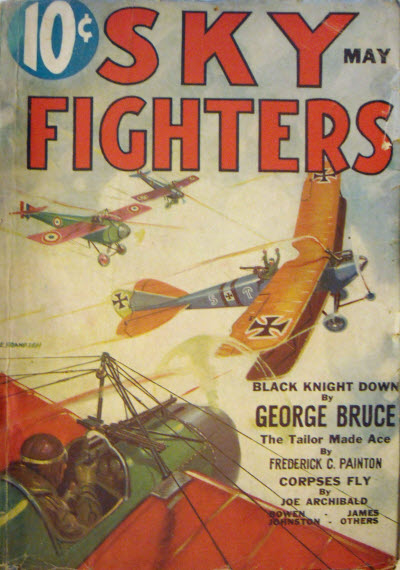 magazine has been exceedingly fortunate in securing R. Sidney Bowen to conduct a technical department each month. It is Mr. Bowen’s idea to tell us the underlying principles and facts concerning expressions and ideas of air-war terminology. Each month he will enlarge upon some particular statement in the stories of this magazine. Mr. Bowen is qualified for this work, not only because he was a war pilot of the Royal Air Force, but also because he has been the editor of one of the foremost technical journals of aviation.
magazine has been exceedingly fortunate in securing R. Sidney Bowen to conduct a technical department each month. It is Mr. Bowen’s idea to tell us the underlying principles and facts concerning expressions and ideas of air-war terminology. Each month he will enlarge upon some particular statement in the stories of this magazine. Mr. Bowen is qualified for this work, not only because he was a war pilot of the Royal Air Force, but also because he has been the editor of one of the foremost technical journals of aviation.
Why It Flys
by Robert Sidney Bowen (Sky Fighters, May 1933)
ALL RIGHT, you buzzards, sit up and take a good look at that young chap sitting over there on the right side of the room. See him? Well, take a second look, because there is one intelligent young man. You said it! Why is he so bright? Well, wait until I read you a letter that I just got from him—
Dear Uncle Wash-Out:
I’ve been listening to your chin-jests since they first began many months ago. I don’t suppose that your head can get any bigger, so I’ll risk saying that I have enjoyed every word, including the periods and quotation marks.
And so, I’m going to take advantage of your offer to ask a question. Here it is. The title of your chin-fests is, “How the War Crates Flew.†Well, how did they? In other words, Uncle Wash-Out, just what makes an airplane fly?
Here’s hoping that you’ll give us some dope regarding the technical side of the actual flight of an airplane.
Hopefully yours,
Charles Barringer.
Well, here I am, Charlie, in the flesh, and all set to grant you your wish. So pay attention and never mind if some of these other buzzards fall asleep. It’s bright lads like you that I like to help out. The others can go walk into a revving prop if they want to. Guess we’ll never miss them, much.
And, so here we go.
The air that we breathe and feel and know is all around us has weight, and it exerts pressure in all directions. Now, the action of air on a kite results in the air being compressed underneath it, and a vaccum being formed above it. That action causes the kite to rise for the simple reason that there is increased pressure on the underneath side and decreased pressure above. To get a good idea of all that, take a look at Fig.1.

FLIGHT is secured by drawing, or propelling, an inclined plane through the air, with the plane inclined upwards and toward the direction of motion. When I speak of plane in that instance I mean a flat plane, not an airplane.
Now, that plane going through the air has four forces working upon it. And those four forces are Lift, Drift, Gravity, and Thrust.
Lift, as the word itself explains, is the tendency for the plane to rise. And that tendency, as I explained above, is the result of increased pressure underneath the plane, and decreased pressure above.
Drift, or as it is often called, Resistance, is the reaction due to the action of propelling a plane through the air, thus retarding its motion. Drift is caused by the eddies of air which hinder the forward motion. You might almost call it a backward suction or drag. And then, too, there is drift, or resistance, caused by the frontal area presented toward the line of flight. To decrease drift as much as possible the thing to do, of course, is to streamline the object that goes through the air.
Take a ball for instance. Fig.2. The air slips around the ball all right, but the vacuum at the rear causes air eddies and these eddies more or less try to suck the ball backwards. And that, of course, hinders the forward flight of the ball.

Now take a look at Fig.3. We have put streamlining on the back of the ball. The result is that the air stream follows along the streamlining, and as a result of there being no vacuum, no eddies are formed to try and drag the ball backwards. Of course, you must understand that I’m speaking generally. There is not as yet, an airplane wing of one hundred percent non-drag efficiency. There is still a small vacuum and there are still eddies caused by that vacuum. But streamlining reduces air resistance to a minimum. And of course not only are the wings of a plane streamlined, but every other part of it. However, what I’m pointing out is how streamlining helps to reduce resistance or drift.

The third force is Gravity, or to be brief, the magnetic attraction of the earth to all things on it and above it, for at least a distance of fifty miles, maybe more. Scientists have not yet determined exactly how high above the earth the force of gravity extends. However, we know that this thing called gravity is an invisible force that draws things earthward.
Thrust is the forward force applied to the plane by the engine actuated by the propeller. Now the prop may push the plane through the air, or it may pull it, but no matter which it does the action is referred to as “thrust.â€
What’s that? Each of those four forces has its opposite? Right you are. Good lad, for figuring that out. Huh? What does he mean? All right, listen.
In plain words the four forces are, upward, downward, forward, and backward. The thrust has its opposite, which of course is drift. And lift has its opposite which is gravity.
NOW, when the engine is off and the plane is on the ground, drift overcomes thrust and gravity overcomes lift. In other words there is no thrust or lift, which is only natural.
And so we start the engine, run it up full out and what happens? Thrust starts to overcome drift, and lift starts to overcome gravity. Eventually the action of lift overcoming gravity points the nose of the plane into the air and the plane rises. Now, so long as your engine is on, the thrust remains the same, regardless of forward speed. However, the greater the forward speed the greater the action of drift.
Maybe that last confused you a bit. How could thrust remain the same, and yet have forward speed increase so that drift increases also? Well, it’s this way. If you were flying into the wind your prop would be trying just as hard to pull you forward, but your speed over the ground would be reduced, and naturally the drift increased. But if you were flying with the wind your ground speed would be increased (because the wind helped blow you along), even though the thrust remained the same.

You probably noted that I put emphasis on the words, ground speed. Well, an airplane in flight always has two speeds. One is air-speed and the other is ground-speed. Now, take a look at Fig.4. A lot of folks get mixed up about the speed of an airplane. And as we all know, a lot of fiction authors go a bit haywire about it. However, as you will note from the figure, air speed is always the same. That is, of course, provided that you keep the throttle in the same place. And I might mention right here that air speed means the speed at which the wings pass through the air. No matter whether it is fifty miles an hour or five hundred miles an hour, it will stay the same in level flight. But the ground speed, the speed at which the plane travels over the ground, is always changing. If there is a twenty-mile wind and you fly into it, your ground speed is reduced twenty miles per hour. And if you fly with that wind your ground speed is increased twenty miles an hour.
So remember, when some one says, “This ship will do 200 m.p.h.,†that he means that the wings will go through the air at that rate of speed. Its speed over the ground will depend upon whether he flies with the wind, or against it.
Now in case you get the idea that I’m suggesting that well-known airplane speed records don’t mean a thing, just let me clear up that point. A straight-away record is taken from the average of two flights with the wind and two flights against it. Therefore the thing is balanced and you get the speed of the plane as though it were flying in still air. And the same holds true for a closed course speed record. One half of the course would be with the wind, and the other half would be against the wind. Get the idea?
BUT we happen to be up in the air just now, and talking about the four forces that are having their own individual effect upon the flight of our ship.
We said that thrust remains the same regardless of speed, but that drift increases, with increased forward speed. Right! Now, it is only natural that drift increases also as the forward speed is reduced. And when the drift is greater than the thrust what happens? It means that gravity has also become greater than lift. The result is that the plane goes earthward. If such a thing happened suddenly and the increase of drift and gravity over thrust and lift was of a great amount, the plane would naturally stall, and thrust and lift would be non-existant for the moment. In other words the plane would start toward earth, out of control until your falling speed became great enough to be flying speed.
That may sound a little complicated. But what I mean is that a plane stalls because drift has become greater than thrust and gravity has become greater than lift.
Huh? What about gliding down?
Now keep your shirt on. I can’t say everything in the same breath. I’m coming to that point right now.
You are flying along and you decide to land. Well, the first thing you do is throttle your engine. That, of course, is an automatic decreasing of your thrust. If you carried straight on at level flight drift would soon take complete charge of thrust and gravity would take complete charge of lift—and you would stall. So you point the nose downward, and let drift gradually overcome thrust and gravity to gradually overcome lift. Of course you take care of that sort of thing with your gliding angle. And then when you get right close to the ground you level off and go straight forward. That, of course, causes drift to overcome thrust (which now is simply gliding speed) at a faster rate. And the same with gravity overcoming lift. Presently thrust and lift become practically non-existant, and your plane stalls—but—you are only a couple of feet off the ground so you simply settle on the ground with no damage done. So in theory, every airplane landing is a stall—drift and gravity, having completely overcome thrust and lift.
Now, that is the general action of the four forces, thrust, lift, draft, and gravity, upon an airplane on the ground and in the air. And, therefore, it means that an airplane flies when thrust is equal to drift, and lift is equal to gravity. When those things are equal momentum carries the plane on. Increased thrust means increased air speed. And increased lift, means increased climbing angle.
Now, before I toss you all out, I’m going to say a few words about the design of airplane wings in regard to lift and drift.

THE length of a wing is called the span. And the width of a wing is called the cord. The relation of the span to the cord is known as the “aspect ratio of a wing.†A square wing would have a low aspect ratio. Whereas a narrow wing would have a high aspect ratio. See Fig.5. Now a high aspect ratio is better than a low aspect ratio for the simple reason that it gives the same amount of lift with less drift.
Now a flat wing, as we know, would have a lot of drift, regardless of its lift. So to lessen the drift the wing is itself streamlined. In other words it is changed from a flat wing to a cambered wing. And because it is cambered the air pressure on its underneath surface is at right angles to it. See Fig.6.

The curvature of a wing determines its lifting efficiency. (We are disregarding streamlining and drift for the moment.) A flat wing has less air pressure beneath, and as a result less upward lift suction on top. As the wing is curved more, both of those things increase. Naturally there is a limit, and aeronautical engineers are continually experimenting for the correct camber of the wings of the planes they design. But the curvature, particularly the curvature at the top is a mighty important item regarding the lifting efficiency of the wing. In the old days it was believed that a wing got its greatest lift from the bottom of the wing. But the wing design developments of recent years have proved that almost sixty-five percent of the lift of a wing is from the top. So camber is not something to toss out the window. Upon it depends maximum lift efficiency, in accordance with the correct angle of incidence (angle of wing toward line of flight).
And so, you might say that the wings of an airplane are the most important. You can always get a good engine, and you can always build a good fuselage, and the other things that go with it. But when you come to the wings, you have a real job on your hands. They have got to be strong enough to stay on when you are going full out. They have got to have maximum lift for the weight they are carrying, and they’ve got to have minimum drift, because you get more drift from your wings than from any other part of the ship.
But after all, drift is only one of the forces you’ve got to think about. There are three others, as I told you—lift, thrust, and gravity. Keep them all in mind, when you design that plane. And remember, thrust has got to equal drift, and lift has got to equal gravity, or you’ll never fly in a hundred thousand years!
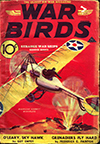 THE U.S. Army, after extensive tests, ordered this odd looking ship for service. At that time it was considered one of the fastest and safest of ships. It was to be partially armored. This feature anticipated Germany’s armoring of ships by several years.
THE U.S. Army, after extensive tests, ordered this odd looking ship for service. At that time it was considered one of the fastest and safest of ships. It was to be partially armored. This feature anticipated Germany’s armoring of ships by several years.






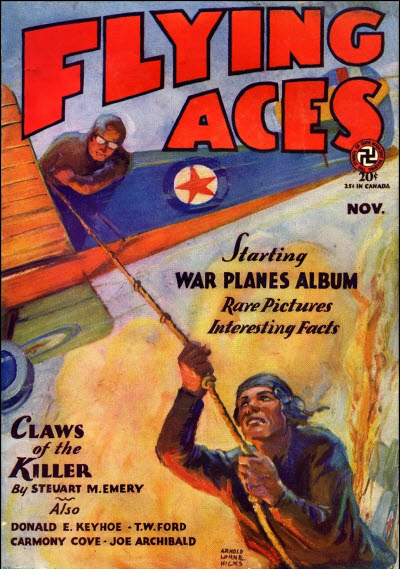 That sound can only mean one thing—that Bachelor of Artifice, Knight of Calamity and an alumnus of Doctor Merlin’s Camelot College for Conjurors is back to vex not only the Germans, but the Americans—the Ninth Pursuit Squadron in particular—as well. Yes it’s the marvel from Boonetown, Iowa himself—Lieutenant Phineas Pinkham!
That sound can only mean one thing—that Bachelor of Artifice, Knight of Calamity and an alumnus of Doctor Merlin’s Camelot College for Conjurors is back to vex not only the Germans, but the Americans—the Ninth Pursuit Squadron in particular—as well. Yes it’s the marvel from Boonetown, Iowa himself—Lieutenant Phineas Pinkham! 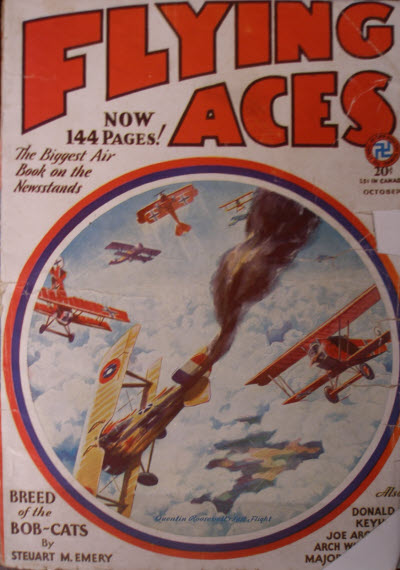 a story from the pen of a prolific pulp author O.B. Myers! Myers was a pilot himself, flying with the 147th Aero Squadron and carrying two credited victories and awarded the
a story from the pen of a prolific pulp author O.B. Myers! Myers was a pilot himself, flying with the 147th Aero Squadron and carrying two credited victories and awarded the 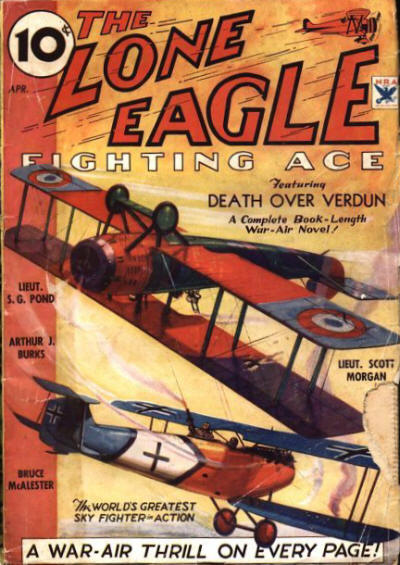 story by “Ace Williams.” I put his name in quotes because
story by “Ace Williams.” I put his name in quotes because  magazine has been exceedingly fortunate in securing R. Sidney Bowen to conduct a technical department each month. It is Mr. Bowen’s idea to tell us the underlying principles and facts concerning expressions and ideas of air-war terminology. Each month he will enlarge upon some particular statement in the stories of this magazine. Mr. Bowen is qualified for this work, not only because he was a war pilot of the Royal Air Force, but also because he has been the editor of one of the foremost technical journals of aviation.
magazine has been exceedingly fortunate in securing R. Sidney Bowen to conduct a technical department each month. It is Mr. Bowen’s idea to tell us the underlying principles and facts concerning expressions and ideas of air-war terminology. Each month he will enlarge upon some particular statement in the stories of this magazine. Mr. Bowen is qualified for this work, not only because he was a war pilot of the Royal Air Force, but also because he has been the editor of one of the foremost technical journals of aviation.





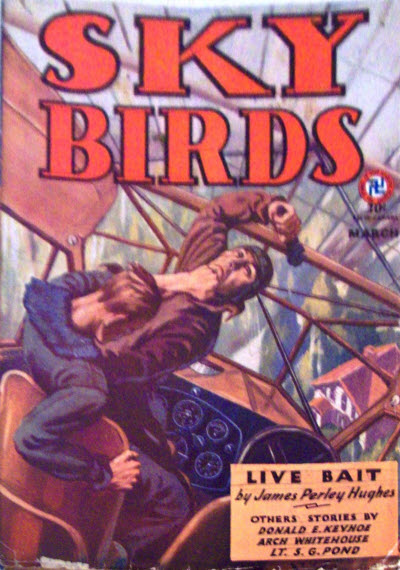 an early story from the pen of Donald E. Keyhoe—his first in the pages of Sky Birds magazine. Keyhoe started appearing regularly in the aviation pulps—Wings, Air Stories, Sky Birds, Flying Aces—starting in December 1929. His series characters started in August 1931.
an early story from the pen of Donald E. Keyhoe—his first in the pages of Sky Birds magazine. Keyhoe started appearing regularly in the aviation pulps—Wings, Air Stories, Sky Birds, Flying Aces—starting in December 1929. His series characters started in August 1931.